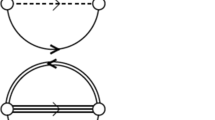Abstract
We show that a quark-diquark model previously introduced to explainSU(6) violations in quasi-two-body reactions is also able to accomodate a (quantitative) interpretation of the negative charge radius of the neutron, provided one uses appropriate hypotheses for the confinements (c.q. sizes) of the quarks and diquarks involved. They effectively imply the existence of a nucleon core (i.e. a massive two-quark state of substantial spatial clustering) with zero spin and zero isospin.
Similar content being viewed by others
References
M. Zralek, W.J. Metzger, R.T. Van de Walle, C. Dionisi, A. Gurtu, M. Mazzucato, B. Foster. Phys. Rev. D19, 820 (1979)
M. Ida, R. Kobayashi: Prog. Theor. Phys.36, 846 (1966)
D.B. Lichtenberg, L.J. Tassie, P.J. Keleman: Phys. Rev.167, 1535 (1968); J. Carroll, D.B. Lichtenberg, J. Franklin: Phys. Rev.174, 1681 (1968); D.B. Lichtenberg: Phys. Rev.178, 2197 (1969)
R.F. Feynman: Photon-Hadron Interaction. New York: Benjamin, 1972
F. E. Close: Phys. Lett.43B, 422 (1973)
J. F. Gunion, D. E. Soper: Phys. Lett.73B, 189 (1978)
See e.g. R. E. Cutkosky, R. E. Hendrick: Phys. Rev. D.16, 2902 (1977) for anSU(6)-conserving modelwith diquark clustering
On the other hand for the other key assumption of the quasi-two-body interpretation (namely the diquarkspectator assumption) spatial quark clustering appears a logical starting point
For more details see R. T. Van de Walle: Subnuclear Physics Series. Zichichi, A. (ed.), Vol. 17. Pointlike Structure inside and outside Hadrons (1979) (to be published)
P.J. Litchfield: Proc. of Topical Conf. on Baryon Resonances, Oxford, p. 339 (1976)
R. J. Cashmore: Proc. of the 19th International Conference on High Energy Physics, Tokyo, p. 811 (1978); G. R. Goldstein, J. Maharana: RHEL-preprint RL-79-048
N. Isgur: Acta Phys. Pol B8, 1081 (1977)
T. Hyashi, T. Karino, T. Yanaguda: Prog. Theor. Phys.60, 1066 (1978)
S. Brodsky “Color symmetry and quark confinement”. Tran Than Van (ed.). Moriond Meeting 1977
L. F. Abbot, E. L. Berger, R. Blankenbecler, G. L. Kane: Phys. Lett.88B, 157 (1979)
B. Andersson, G. Gustafson, G. Ingelman: Phys. Lett.58B, 417 (1979)
I. Schmidt, R. Blankenbecler: Phys. Rev. D16, 1318 (1977)
K. Johnson, C. Thorn: Phys. Rev. D13, 1934 (1976); G. Preparata, K. Szego: Nuovo Cimento47 A, 303 (1978)
S. D. Drell, H. Quinn, M. Weinstein: SLAC-report (to be published)
R. D. Carlitz, B. D. Creamer: Phys. Lett.84B, 215 (1979)
H. J. Lipkin: Phys. Lett.35B, 534 (1971)
N. Isgur, G. Karl: Phys. Lett.74B, 353 (1978); Phys. Rev. D18, 4187 (1978); Phys. Rev D19, 2653 (1979); N. Isgur, G. Karl, R. Koniuk: Phys. Rev. Lett.41, 1269 (1978); R. Koniuk, N. Isgur: Phys. Rev. D21, 1868 (1980)
Z. Dzimbowski, W. J. Metzger, M. Zralek: University of Nijmegen, Internal Report HEN-191, 1980 (to be published)
R. D. Carlitz, S. D. Ellis, R. Savit: Phys. Lett.68B, 443 (1977)
L. M. Seghal: Phys. Lett.53B, 106 (1974); F. E. Close, F. Halzen, D. M. Scott: Phys. Lett.68B, 447 (1977)
J. Kuti, V. F. Weisskopf: Phys. Rev. D4, 3418 (1971); O. Nachtmann: Nucl. Phys. B38, 397 (1972)
E. Hirsch, U. Karshon, H. J. Lipkin, Y. Eisenberg, A. Shapiro, G. Yekutieli, J. Goldberg: Phys. Lett.36B, 139 (1971); J. C. Kluyver, R. Blokzijl, G. G. G. Massaro, G. F. Wolters, R. Armenteros, R. J. Hemingway, S. O. Holmgren, P. Grossman, P. R. Lamb, J. Wells: Nucl. Phys. B140, 141 (1978)
Another (welcome) consequence of the above assumption is that it immediately explains the absence of the {20} baryon multiplet and the dominance of the 0+, 1−, 2+, 3−... etcSU(6) multiplets. See [1]. To explain the so-called minimal spectrum, i.e. {56} with only 0+, 2+... and {70} with only 1−, 3−,..., requires one more additional assumption, namely that of a sizeable exchange force between quark and diquark. See D. B. Lichtenberg: Phys. Rev.178, 2197 (1968). Although the above findings apply for strictSU(6) they will remain approximately true in any situation where theSU(6) symmetry is not too strongly broken in its internal quantum-numbers
There exists a relation between factorizability of the spatial parts of a wave function andSU(6) breaking. See P.M. Fishbane, J.S. McCarthy, J.V. Noble, J.S. Trefil: Phys. Rev. D11, 1338 (1975)
V. E. Krohn, G. R. Ringo: Phys. Rev. D9, 1305 (1973); L. Koester et al.: Phys. Rev. Lett.36, 1201 (1976)
F. Borkowski, P. Peuser, G. G. Simon, V. H. Walther, R. D. Wensling. Nucl. Phys. A222, 269 (1974)
The assumptions (21) can only be approximately true. In principle they disagree with the assumption that the odd-quark coupling to the diquark is different for theI=0 and for theI=1 diquark. A priori one should therefore also expect different odd-quark confinement quantities. However, the difference between 53° and 45° is presumably small enough so as not to exclude the approximation contained in assumptions (21)
To be more precise with Γ=53°, and assumptions (21) and (24), the Eqs. (22) and (23) require\(\left\langle {r^2 } \right\rangle _{D_O } \simeq 0.07{\rm{ }}R^2\) at a 1 SD level
The quasi-two-body results of [1] also remain valid. In terms ofinternal variables the diquark-quark wave functions used were complete descriptions of the baryon states considered anyway, even in the absence of real dynamical diquark clustering. In the latter situation it is primarily the diquark spectator assumption which becomes questionable. However as noted already in the analysis of [1] the spectator assumption could in principle have two (distinct) dynamical origins; one is real spatial clustering; the other a ‘filter’ resulting from the limitation of looking at peripheral quasi-two-body reactions only. The charged nucleonradii results suggest that the first mechanism is present in theI=0 diquark case while the latter one is at work for theI=1 two-quark states
M. Zralek: University of Nijmegen, Internal Report HEN-190, 1979 (unpublished)
F. Gunion: Phys. Rev. D10, 242 (1974)
See. e.g. P. Collins, F. Gault: Phys. Lett.73B, 330 (1978); H. I. Miettinen, G. H. Thomas: Fermilab-Pub-79/53-THY
R. Carlitz: Phys. Lett.58B, 845 (1975)
Author information
Authors and Affiliations
Rights and permissions
About this article
Cite this article
Dziembowski, Z., Metzger, W.J. & Van de Walle, R.T. Diquark clustering and the neutron charge radius. Z. Phys. C - Particles and Fields 10, 231–238 (1981). https://doi.org/10.1007/BF01549731
Received:
Issue Date:
DOI: https://doi.org/10.1007/BF01549731



